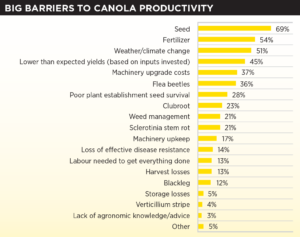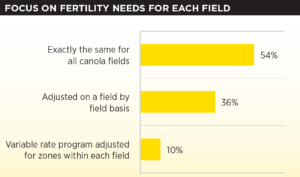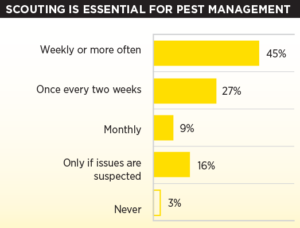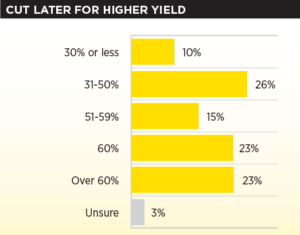Grower survey identifies big agronomy challenges
The Canola Council of Canada grower survey of 2020 identified practices that have an impact on yield and profitability, and showed the adoption rates for our canola best management practices. Canola Council of Canada (CCC) agronomy specialists will use these results to focus on those practices that, if adopted, show the greatest capacity to improve grower profitability and productivity.

Use 4R to get more from fertilizer
When the survey asked growers, “Outside of canola market prices and trade blockages, what are the biggest barriers to canola profitability on your farm?”, the most common answer was seed cost. Second was fertilizer cost.
Growers can improve the return on investment for fertilizer by following 4R nutrient management practices – the right source of fertilizer used at the right rate, at the right time and in the right place.
Yet, the survey found that only 24 per cent of growers have a 4R fertilizer management plan developed with a certified 4R agronomist. Of those who don’t have a plan, 28 percent have never heard of 4R.
More than half (54 percent) of growers have the same fertilizer plan for all canola fields, while 4R would like to see a fertilizer plan tailored to each field.
In central Saskatchewan (a band that arcs from Oxbow, through Warman to Lloydminster), 47 per cent of growers soil test “less often (than every fourth year)” or “never”. This is by far the lowest level of soil testing – making it a region worthy of focused attention – but all regions have room to improve.
While 4R is important everywhere, the southwest Prairies (the Brown Soil Zone, basically) shows the strongest connection between 4R and yield. In this region, 40 per cent of top yielders have a 4R nutrient management plan developed with a certified 4R agronomist, while only 14 per cent of lower yielders have such a plan.
The CCC goal is to have 90 per cent of acres under 4R by 2025, so there is work to do.

Focus on the top yield robbers
Yields have improved since the last major survey in 2011, but are still well below the industry stretch goal – which is to achieve 52 bu./ac. average yield by 2025. Average for growers surveyed in 2011 was 39 bu./ac. For the 2020 survey, average yield for the past five years was 43 bu./ac.
Canola’s genetic potential for yield is well over double that amount. For canola to reach its maximum yield potential, the CCC would like growers to start with a target stand of five to eight plants per square foot, achieve uniform emergence, and set a fertilizer rate based on soil test analysis and recommendations. We’d also like to see growers choose the best genetic package for the situation in each field. Beyond that, a big step in improving yield comes down to managing the major “yield robbers”.
Pest management begins with regular scouting. Forty-five percent of canola growers scout weekly, or more often. We’d like to see that closer to 100 percent because pest issues can flare up so quickly.
When asked, “What pests are the greatest economic risk to your canola production?”, flea beetles and sclerotinia stem rot were the top two. Rounding out the top six were herbicide-resistant weeds, clubroot, bertha armyworm and blackleg.
Growers are good at scouting (or hiring someone to scout) for flea beetles – 89 per cent say they do this. That drops to 47 per cent each for cutworms and bertha armyworm, and then lower for all other insects. Sclerotinia spray decisions are a challenge, and growers who decide to spray usually make that decision based on yield potential and moisture. Only 10 per cent of survey respondents say they use the sclerotinia check list.
Find scouting and management tips for all major canola pests in the Diseases, Weeds and Insects chapters at canolaencyclopedia.ca.
Let those seedpods fill
Average canola yields could increase quite a bit with later cutting. The survey found that 81 per cent of canola growers swath all or some of their canola acres. Of the swathers, 10 percent swath based on a target seed colour change of 30 percent or lower, 26 percent target 31-50 percent and 15 percent target 51-59 percent.
This is despite pretty strong evidence that yields get better with later swathing, and that 60 per cent seed colour change – or later – is a much better target.
The bottom line, based on these results, is that about half of swathed canola acres are swathed too early for maximum yield.
We have a lot of research to support later swathing. CCC research trials from 2000-02 compared swathing at 20-30 percent SCC to later timing. Results showed a yield benefit of eight per cent by waiting until 50-60 per cent SCC and 11 per cent by waiting until 60-70 per cent SCC. In a 2013 study, Indian Head Agricultural Research Foundation (IHARF) compared two swath timings – 20-30 percent SCC and 50-60 percent SCC. Results showed that swathing at 20-30 per cent SCC resulted in the lowest seed yield, and waiting a week increased canola yields by nearly nine per cent. For hybrids with the pod-shatter trait, recent BASF research shows that yield continues to climb when growers swath these hybrids at 80 per cent or straight combine them.
The benefits of waiting are more pronounced these days because canola populations are lower, so more yield comes from side branches. Extra time is essential to allow seeds on side branches to reach their full size and weight.
These are just a few of major agronomy challenges that surfaced when we analyzed the 2020 grower survey results. For our timely agronomy updates, please sign up for Canola Watch at canolawatch.org. Find detailed science-based agronomy tips at canolaencyclopedia.ca.






